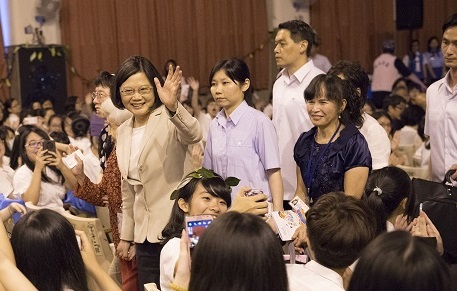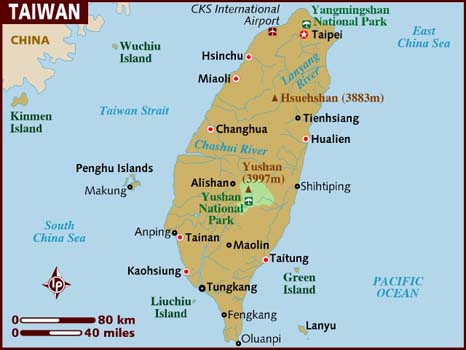Taiwan gets an American boost
April 3, 2019 | Expert Insights

Taiwan is set to purchase fourth-generation F-16V fighters from the US, while China continues its incursions into American-allied countries in opposition to US Indo-Pacific policy.
Background
The island nation of Taiwan is a highly contested region in East Asia. While Taiwan is considered a province in “Greater China,” it is largely an independent state. This ambiguity can be traced back to 1927 when the seeds of a civil war were sown between the Kuomintang (KMT)-led government of the Republic of China, and the Communist Party of China (CPC). Both parties wrestled for control over China. While the civil war lasted between 1927 and 1950, the main phase is considered to be from 1945 to 1949.
The war came to an end when CPC captured Beijing. The leader of CPC, Mao Zedong, then officially declared the formation of the People’s Republic of China (PRC). The leader of the opposing faction, Jiang Jieshi fled to Taiwan. It is here that he declared the formation of the Republic of China (ROC). PRC has repeatedly used the threat of force to ensure Taiwan (ROC) never declared independence.
Taiwan has a democratically elected President (Tsai Ing-wen), laws and its very own armed forces. Taiwan pursues independent informal relations with other countries. Its most influential friend in world politics is the US, which has supported it for decades while also adhering to the “One China” policy.
After a recent move by the Communist Party, Chinese President Xi Jinping has been allowed to rule indefinitely. Mr. Jinping has been firm on his “One China” rhetoric and repeatedly warned against separatism. PRC has recently been embroiled in a geopolitical struggle in the South China Sea, in addition to a trade war with the US. PRC recently sent two fighter jets across the tacitly understood line that divides the PRC and Taiwan.

Analysis
In response to recent aggression by the PRC by way of airspace infringement, Taiwanese President Tsai Ing-wen wrote in a Facebook post, “I have already ordered the military to stage a forceful explosion in the first place against any provocation by incursion of the median line (that divides Taiwan and the PRC).” Earlier intrusions by Chinese fighter jets did not last as long as the recent ten-minute incursion, resulting in the strong rhetoric by Ms. Tsai. Taiwan had scrambled interceptors and broadcast warnings at the two intruding People’s Liberation Army’s (PLA) J-11 jets.
Taiwan has long-implemented a standard operating procedure against Chinese incursions into its territory. However, the prolonged intrusion demanded that Ms. Tsai engage in more provocative rhetoric, especially given her determined position to refuse Beijing’s One China principle. Employing a calculated response, Ms. Tsai risked a cross-strait row in order to portray herself as resilient against a PRC threat in face of looming elections in 2020.
Analysts have suggested that the incursion by PRC was a calculated one, intended to respond to US naval “freedom of navigation” exercises in the region. In the past year, PLA aeroplanes have also intruded into the airspace of other US partners such as Japan and South Korea, indicating that the incursion maybe a part of countering American moves in the Indo-Pacific. If this is the case, then the PRC has begun to care less about Taiwanese perception and domestic politics in the region, instead choosing to focus on Taiwan’s cooperation with the US.
Simultaneously, US President Trump’s administration has provided tacit approval to Taipei to procure over 60 Lockheed Martin F-16Vs. While the move will hardly mean parity between Taiwan and its greatest existential threat - the PRC, it signals a greater willingness by America to overtly back the island nation, in a seeming abandonment of the One China policy. The move comes amidst monthly US freedom of navigation exercises in the region, in addition to steady support for the democratically elected government in Taipei. America’s push towards negating the threat to its supremacy posed by the PRC is directed in a “whole of government” manner, intended to employ every available facility in its stance. The sale of previously denied advanced weaponry to Taiwan is aimed at testing how far China is willing to allow Taiwan’s rearmament, without actually breaching this line. This analysis is bolstered by the refusal of the US to sell F-35s to Taiwan, which could compete with the PRC’s most advanced fighter while providing the F-16Vs, which would still bolster its defences.
Assessment
Our assessment is that Ms. Tsai’s strong rhetoric against recent Chinese incursions is intended to display her resilience against the threat posed by the PRC while shoring up support for her pro-independence party come to the 2020 elections. We believe that the US is actively trying to negate China’s rise to power by using every means necessary to stifle its growth. We believe that the recent sale of F-16s won’t tip the balance in Taiwan's favour but instead makes a powerful normative adjustment to the power balance in the region.
Image Courtesy: 總統府 [CC BY 2.0 (https://creativecommons.org/licenses/by/2.0)]
Read more:








Comments